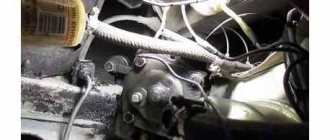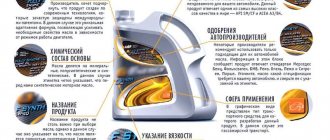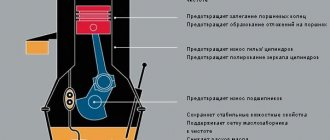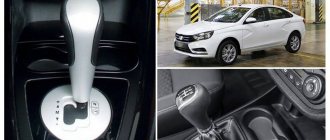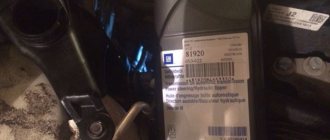It’s good when the car is new and you don’t have to think about where and when to service your iron horse. Another thing is when you bought a used car whose warranty has expired, it is clear that there is no point in continuing to service the car from an official dealer. In today's article we will talk in detail about how to independently change the oil in the DSG-7 gearbox in a Volkswagen Passat CC (there is practically no difference between changing the restyled and derestyling version, at least the process itself is completely similar). We will also consider the issue of choosing which oil The official dealer recommends filling the oil and what oil is best suited as an analogue so that you can save a little.
Owners of a used Volkswagen Passat SS 1.8 with DSG-7 often have a question: do they need to change the oil in the box or not? Disputes arise due to the fact that the DSG-7 uses a dry clutch, which is why many people mistakenly think that there is no oil in the box and therefore there is nothing to change. Let us hasten to dispel this myth.
What kind of oil should I use?
It is best to pour gear oil G 052 512 A2 recommended by the manufacturer; it is sold in liter bottles at a price of 900 to 1,300 rubles, depending on the region. This product is suitable for manual and robotic transmissions (DSG-7 DQ 200) installed on Audi, Skoda, SEAT and Volkswagen.
As an alternative, some use:
- FEBI 21829 price from 500 rubles per 1 liter;
- SWAG 10921829 price from 500 rubles per 1 liter;
- VAG GCN052512Z2 price from 900 rubles per 1 liter.
Step-by-step instructions for changing the oil yourself
Before proceeding to the description of the actions, in addition to the oil, you will need a drain plug; its cost is 170 rubles. The tools you will need are a “10” hexagon, a syringe with a flexible hose and the actual container where the old oil will be drained. This process must take place on a warm transmission. so let's get started:
- remove the plastic protection;
- unscrew the gearbox plug;
- drain the oil;
- tighten the plug;
- install plastic protection;
- remove the cap from the breather;
- insert the tube into the hole;
- fill in the oil (Important! you need to fill in exactly as much oil as the old one has poured out, since the box is not equipped with a dipstick, you will have to do the calculations yourself);
- put the breather cap in place.
That’s basically the whole process, which shouldn’t cause any particular difficulties or take a long time. By the way,
Question 001: Q: What is DSG? What types of DSG are there? What is the difference? What cars are they installed on? A: DSG (from German DirektSchaltGetriebe or English Direct Shift Gearbox) is a family of preselective robotic transmissions with dual clutches installed on VAG cars (Audi, Volkswagen, Skoda, Seat).
| Type | Clutches | Engine location | Engine sizes | Drive unit | Moment | What car models can it be installed on? |
| DSG7 0AM (DQ200) | "dry" | transverse | 1.2 -1.8 | front | 250Nm | Audi: A1, A3 (8P - until 2013), TT; VW: Golf6, Jetta, Polo, Passat, Passat CC, Scirocco, Touran, Ameo; Skoda: Octavia (1Z - until 2013), Yeti, Superb, Fabia, Roomster, Rapid; Seat: Altea, Leon (1P - until 2013), Toledo. |
| DSG6 02E (DQ250) | "wet" | transverse | 1.4 — 3.2 | front/full | 350Nm | Audi: A3 (8P - until 2013), TT, Q3; VW: Golf, Passat, Touran, Scirocco, Sharan, Tiguan; Skoda: Octavia (1Z - until 2013), Yeti, Superb; Seat: Altea, Leon (1P - until 2013), Toledo, Alhambra. |
| DSG7 0B5 (DL501) | "wet" | longitudinal | 2.0 — 4.2 | full | 550Nm | Audi: A4 (until 2015), A5, A6, A7, Q5, RS4, RS5. |
| DSG7 0BT/0BH (DQ500) | "wet" | transverse | 2.0 — 2.5 | front/full | 600Nm | Audi: Q3, RS3, TTRS; VW: Transporter/Multivan/Caravelle, Tiguan. |
| DSG7 0CW (DQ200) | "dry" | transverse | 1.2 — 1.8 | front | 250Nm | Audi: A3 (8V - from 2013), Q2; VW: Golf7, Passat (from 2015), Touran (from 2016); T-Roc. Skoda: Octavia (5E - from 2013), Rapid (from 2013), Karoq, Scala (from 2022); Seat: Leon (5F - since 2013). |
| DSG6 0D9 (DQ250) | "wet" | transverse | 1.4 — 2.0 | front/full | 350Nm | Audi: A3 (8V - from 2013), Q2; VW: Golf7, Passat (from 2015), Touran (from 2016); Skoda: Octavia (5E - from 2013), Kodiaq; Seat: Leon (5F - since 2013), Ateca. |
| DSG7 0DL (DQ500) | "wet" | transverse | 2.0 | front/full | 600Nm | VW: Arteon, Passat (from 2022), Tiguan (from 2016); Skoda: Kodiaq. |
| DSG7 0GC (DQ381) | "wet" | transverse | 2.0 | front/full | 420Nm | Audi: A3 (from 2022), Q2; VW: Arteon, Golf (from 2022), Passat (from 2017); T-Roc. Skoda: Karoq; Seat: Ateca. |
| DSG7 0CK (DL382-7F) | "wet" | longitudinal | 1.4 — 3.0 | front | 400Nm | Audi: A4 (8W - from 2016), A6 (from 2011), A7 (from 2016), Q5 (from 2013). |
| DSG7 0CL (DL382-7Q) | "wet" | longitudinal | 2.0 — 3.0 | full | 400Nm | Audi: A4 (8W - from 2016). |
| DSG7 0СJ | "wet" | longitudinal | 2.0 | full (Ulta Quattro, with electromechanical clutch) | 400Nm | Audi: A4 (8W - from 2016). |
Looking at the table, we can draw some simple conclusions: 1. DSG with “dry” clutches, as a rule, are installed on less powerful engines, because
are able to “digest” a smaller moment. 2. If you have all-wheel drive, then you have “wet” clutches. 3. If you have a DSG and a longitudinal engine, then you have an Audi :-) 4. Apparently, the age of the legendary Audi Quattro all-wheel drive with the famous Torsen differential is coming to an end. Question 002:Q: How can I find out which gearbox is installed on my car? A: Option 1: Connect to the car with a diagnostic tool, go to block 02 - Transmission electronics and read the identification data. The first three characters of the box and mechatronics identifiers identify your box. For example: 0AM 300049H - seven-speed DSG with dry clutches type 0AM. Or 02E 300051R - six-speed DSG with wet clutches like 02E, etc. Option 2: Look by the vehicle's VIN code in the ETKA electronic spare parts catalog. Option 3: Send the vehicle's VIN code to our address, we will check and send you an answer. Question 003: Q: How does S-tronic for Audi differ from DSG for Volkswagen/Skoda/Seat? A: Nothing. With the exception of boxes 0B5, 0CK/0CL and 0СJ which are installed only on audio. Question 004: Q: What kind of oil is poured into the DSG? A: For convenience, we have formulated the answer in the form of a table:
| Type | Oil | Replacement interval (manufacturer's recommendation) |
| DSG7 0AM (DQ200) | for the entire service life | |
| DSG6 02E (DQ250) | Filling volumes: up to 6.9l - full filling up to 5.5l - oil change Filter element: 02E 305 051 C | 60 000 |
| DSG7 0B5 | Gearbox oil DSG G 052 529 up to 7.5 l - full filling up to 6.7 l - oil change Filter element: 0B5 325 330 A | 60 000 |
| DSG7 0BT/0BH (DQ500) | Gearbox oil DSG G 052 182 up to 7.6 - full filling up to 6.0 l - oil change Filter element: 0BH 325 183 B | 60 000 |
| DSG7 0CW (DQ200) | In the box: Gearbox oil G 052 512 — 1.9 l In mechatronics: Hydraulic oil G 004 000 — 1 l | for the entire service life |
| DSG7 0D9 (DQ250) | In the box: Gearbox oil DSG G 052 182 Filling volumes: up to 6.9 l - full fill up to 5.5 l - oil change Filter element: 02E 305 051 C In the transfer case: G 052 145 - 0.9 l | 60 000 |
| DSG7 0DL (DQ500) | In the box: Gearbox oil DSG G 052 182 Filter element: 0BH 325 183 B In the transfer case: G 052 145 | 60 000 |
| DSG7 0GC (DQ381) | ATF oil: G 055 529 | 60 000 |
| DSG7 0CK (DL382-7F) | ATF oil: G 055 549 A2 4.35l - full filling 3.5l - oil change | 60 000 |
| DSG7 0CL (DL382-7Q) | ATF oil: G 055 549 A2 4.35l - full filling 3.5l - oil change MTF oil: G 055 529 A2 - 3.8l | 60 000 |
Question 005:Q: What is mechatronics?
A: Mechatronik (mechatronik, mechatron, valve body, brain) - electronic-hydraulic control unit for the gearbox. Perhaps the most important, but at the same time the most unreliable unit in the entire transmission. Question 006: Q: What is the difference between mechatronics? A: Each type of DSG has its own type of mechatronics. Mechatronics from different types of DSG are not interchangeable. Moreover, for some types of DSG there are several generations of mechatronics, which also differ from each other. And for each type and generation of mechatronics, there are many versions of software designed for different engines and different gear ratios in the gearbox. In some cases, mechatronics of the same type can be reprogrammed (reflashed) for installation on different vehicles. You can read more about the firmware. Question 007:Q: Which DSG is better/more reliable? A: There is no clear answer to this question. Each type of DSG has its own advantages and disadvantages. And the “life” of any DSG largely depends on its operating conditions, such as: - Ambient temperature. All DSGs do not like overheating, especially for DSGs with “dry” clutches, in which the mechatronics have a separate oil circuit and there is no cooling; — Driving mode. Those who spend several hours every day in traffic jams have a greater chance of coming to replace mechatronics than those who mainly drive long distances on the highway; — Driving style. For those who like to “give the corner” and “light up at traffic lights”, the likelihood of having to replace the clutch and differential is much higher than for those who prefer a quiet ride. Question 008:Q: I have DSG7 0AM. Do I need to switch the selector to neutral when standing at a traffic light or in a traffic jam? A: No need. Unlike conventional manual gearboxes, the DSG7 0AM has a normally open clutch. And it closes only when the mechatronics begins to extend the clutch release rods. When you (or autohold) press the brake and hold the car in place, the mechatronics clutch rods are retracted and the clutches are open. Accordingly, no load is transferred to the gearbox or clutch. It doesn’t matter what position the selector knob is in. Question 009:Q: Over time, jerks appeared when changing gears. Previously, the car drove normally, the shifts were smooth, but recently there have been jerks and bumps when changing gears. Can this be fixed by reprogramming the transmission ECU (software update)? A: No you can't. The software cannot “deteriorate” over time and cause the CP to malfunction. If the car previously drove correctly, and then stopped, then the problem lies in the hardware, and not in the software. Reprogramming the mechatronics can only help if the mechatronics were changed and a unit with incorrect software was installed. You can read more about reprogramming. Question 010:Q: How to find out the software version in mechatronics? Question 011:Q: The DSG7 gear shift knob is locked in position P, how to unlock it in order to shift the gearbox to neutral? A: Brief instructions for unlocking the DSG7 0AM selector.
Question 012:Q: Will changing the oil in the DSG7 0AM(0CW) mechatronics help eliminate “kicks” during gear shifts? A: No, it won't help. Such malfunctions can be eliminated by repairing the hydraulic part of the mechatronics. In the initial stages, adaptation (basic installation) can help, but as an exception rather than a rule.
Question 014:Q: After replacing the mechatronics DSG7 0AM, the event recorder displays errors “06247 P1867 - Drive data bus, no messages from the steering column electronics - J527” and “06227 P1853 Drive data bus, unreliable message from the ABS control unit.” How to remove them? A: It is necessary to reset information about installed components (steering column switches, electric parking brake, etc.). To do this, you need to make a basic installation on channel 69. After completing the basic installation, the errors will go from the “constant” state to the “sporadic” state and they can be deleted.
When using VCDS software (VAG-COM, VASYA-Diagnostic, etc.): “02-Gearbox Electronics” -> “Basic. parameters - 04" -> In the "Group" field enter the value 69 -> Click "Read".
When using VAS-PC software: “Self-diagnosis” -> “02-Gearbox electronics” -> “006-Basic installation” -> In the “Group” field, enter the value 69 -> Press “Q”.
When using ODIS software: “Self-diagnosis” -> “02-Gearbox electronics” -> “Basic installation” -> Enter the value 69 -> Click “Channel selection”.
After the basic installation, you should clear the event recorder.
Question 015:Q: Structurally, DSG7 0AM and DSG7 0CW are almost identical transmissions (DQ200 family), is there any difference between the mechatronics installed on them? A: The main difference is the physical and software changes to the electronic control board. In particular, 0CW boards are tied to the vehicle immobilizer system. You can read more about the differences in mechatronics 0AM and 0CW.
The manufacturer itself states that the DSG robot is highly reliable and is an advantageous solution compared to traditional hydromechanical automatic transmissions or CVTs. One way or another, it is important to understand that this box requires regular and high-quality maintenance, taking into account a number of features of its design.
Such maintenance should be understood, first of all, as changing the oil in the DSG, as well as the DSG. Next, we will talk about when the oil in the DSG needs to be changed, how the oil in the DSG box is changed, and also what to pay attention to during this procedure.
Read in this article
Box DSG-7 DQ500: which models are installed on
Audi
- Q3 2.0 TFSI Quattro 170-220 l. With.
- Q3 2.0 TDI 140 l. With.
- Q3 2.0 TDI Quattro 150-184 l. With.
- RS Q3 2.5 TFSI Quattro 340-367 l. With.
- RS Q3 2.5 TFSI Quattro 400 l. With.
- TT RS 2.5 TFSI Quattro 400 l. With.
Volkswagen
- Transporter 2.0 TDI 140-204 l. With.
- Transporter 2.0 TDI 4Motion 150-204 l. With.
- Multivan 2.0 TDI 140-204 l. With.
- Multivan 2.0 TDI 4Motion 140-204 l. With.
- Caravelle 2.0 TDI 140-204 l. With.
- Caravelle 2.0 TDI 4Motion 140-204 l. With.
- Tiguan 2.0 TDI 4Motion 177-184 l. With.
- Tiguan 2.0 TSI R-Line 4Motion 210 l. With.
- Tiguan II 2.0 TDI 4Motion 150-180-hp With.
- Tiguan II 4Motion 180-220 HP With.
- Passat B8 2.0 TDI SCR 4Motion BlueMotion 240 l. With.
Skoda
- Kodiaq 2.0 TDI 4x4 150 l. With.
- Kodiaq 2.0 TSI 4×4 180 l. With.
Changing transmission oil in a DSG robot: when is it needed and why
So, the specified gearbox is based on a manual transmission, as well as (by analogy with a manual transmission). In other words, unlike “classic” automatic transmissions or a variator, there is no torque converter.
There are two clutch discs, making gear shifts very quickly and smoothly. The result is a high level of comfort and fuel efficiency, as well as impressive acceleration dynamics, since there is virtually no interruption in the power flow during shifts, etc.
Controls the operation of the gearbox and clutch, as well as (analog). In fact, the electronic unit sends signals to the actuators, after which, due to the redistribution of fluid (oil) flows in the mechatronics, gears are engaged and other processes are controlled.
It is quite obvious that the presence of such a device as mechatronics means increased requirements for the quality and condition of transmission oil. In other words, a timely oil change in the DSG gearbox is necessary.
Let us immediately note that according to the regulations, an oil change in the DSG-6, and also often in the DSG-7, is required every 60 thousand km. However, if the car is operated in difficult conditions (trailer towing, aggressive driving, maximum loads), the transmission oil needs to be replaced earlier (the interval is reduced by 20-30 or even 40%).
Please note that DSG-6 is and can last about 200-250 thousand km. without repair. At the same time, it is important to understand that the result of a timely oil change in the gearbox simultaneously with violation of operating requirements for the gearbox is the result of the vast majority of DSG breakdowns that occur.
Also, after an oil change, most owners note that after the change, for example, in the DSG-6, the shocks when switching disappear, the gearbox operates smoothly, without jerking. Next, we will look at the process of changing the oil in the DSG-6 with our own hands.
How is DSG7 different?
VAG cars are equipped with two main types of DSG transmissions. Some of them have a wet clutch, while others have a dry clutch. The latter are called DSG7. Their design does not require a hydraulic clutch cooling system. For this reason, such a transmission does not tolerate work in traffic jams and congestion: the lack of incoming air flow often leads to overheating and failure.
A distinctive feature of this model is the limitation of the torque of the motors used. They are equipped with the concern's cars, whose maximum thrust is within 250 Nm.
How to easily and quickly update the lubricant in a gearbox?
How to select and change oil in DSG
So, in order to change the oil in the DSG, you must first select a special transmission fluid or oil for the DSG box that is suitable for units of this type. To change the oil in a DSG box, for example, DQ-250, you will need 6 liters of gear oil.
Considering that such a gearbox has a “wet” clutch (clutch packs are immersed in an oil bath), in this case more oil is needed. As for the DSG-7 with the so-called “dry” clutch, such a box requires less transmission fluid.
We also note that in addition to the fluid, it is necessary to change the oil filter of the DSG box, as well as the special sealing ring of the drain plug. As a rule, when replacing, original oils and transmission fluids with VW TL52182 approvals are used. You can also select suitable analogues from third-party manufacturers.
The main thing is to use high quality products as well. If we talk about the replacement itself, you can either use the services of specialized service stations or perform all the manipulations yourself.
- First of all, in addition to the oil and gearbox filter, you will need a garage with an inspection hole or a lift, a set of tools, containers for draining waste, rags;
- Before starting the replacement, the box must be warmed up by driving the car for about 10 km;
- Next, the machine is placed on a pit or raised on a lift; if present, the engine protection is removed;
- Then you will need to remove the air intake along with the air filter, battery with casing and pan;
- Next, the plastic cup is unscrewed and the filter is removed;
- Then you need to remove the breather cap (located closer to the headlight from the filter);
- Now you can go down under the car and unscrew the drain plug, place a container into which the waste will be drained;
- After unscrewing the plug, an allen key is inserted into the hole, which is used to unscrew a special insert. This allows you to drain the maximum amount of oil;
- After removing the insert, you need to wait until all the oil has drained into the container;
- At the same time, you need to saturate the new DSG box filter with fresh oil. To do this, you can insert the filter into the cup housing and pour oil into it;
- After the oil has completely drained from the gearbox, the insert can be screwed in, but there is no need to screw in the drain plug. If you screw it in, the oil will be poured into the unit faster;
- To avoid oil leaks, place a container in the area of the drain hole.
- Now all that remains is to insert a funnel into the gearbox breather (from above under the hood) and fill in fresh oil. You should pour slowly and carefully, dosing portions.
Let us also add that you can fill the oil in other ways (for example, pump it with a syringe through the drain hole), but in practice, filling through the breather is the fastest and most effective. Also, after about 4.5 liters of oil have been poured into the box, you need to tighten the gearbox oil filter cap, replace the breather cap, install the previously removed elements of the engine intake system, and connect the terminals to the battery.
There is no need to tighten or tighten anything yet. At the same time, the old gearbox drain plug is installed (we are not installing a new one yet, and the o-rings are not changing either). Next, you need to start the engine, connecting in parallel to the ECU via.
The main task is to wait until the oil in the DSG warms up to 40-48 degrees. After such heating, there is no need to turn off the engine; however, the old drain plug should be unscrewed. It is important that the oil drips slightly from the hole as a result of the vibrations of the running engine.
Then you need to wait some time until the excess flows out, that is, the required amount remains in the gearbox (a plug insert installed in the drain hole will not allow more lubricant to leak out). Please note that if, when you unscrew the plug, the oil does not immediately drip, this indicates that it is not filled enough and needs topping up.
Once the oil stops dripping, this will indicate the required oil level in the gearbox. In this case, you can screw in a new plug with an o-ring and also turn off the engine. Now you can begin reassembly by tightening all previously removed and unscrewed elements. At this point, the oil change can be considered complete.
Box DSG-7 DQ200: which models are installed on
Volkswagen
- Bettle A5 1.2 (105 hp) and 1.4 (160 hp)
- Jetta 6 1.4 122 l. With.
- Passat B6 1.4 122 l. With.
- Passat B6 1.8 152 l. With.
- Passat B8 1.4 (125-150 hp) and 1.8 (180 hp)
- Polo 5 1.2 (90 hp), 1.4 (110 hp)
- Golf Plus 2 1.2 (105 hp), 1.4 (122 hp), 1.6 (106 hp)
- Scirocco 3 1.4 (122-166 hp)
- Touran 1.6 TDI
Skoda
- Fabia RS 2 1.4 180 l. With.
- Octavia 1.4, 1.8 TSI
- Rapid 1.4 TSI
- Supereb 2.0 TDI (front-wheel drive and all-wheel drive)
- Yeti 1.2 (105 hp), 1.4 (122 hp)
- Octavia A7 1.8 180 l. With.
Audi
- A3 8V 1.4 TFSI 122 l. With.
- A1 8×4 122 l. With.
- TT0
Seat
- Altea 1.6 TDI
- Leon 2 1.8 (1P – until 2013)
- Toledo 4TSI
What is the best way to change: on your own or at the bus station?
In the context of the need to save the family budget, this issue is becoming increasingly relevant for car enthusiasts. Of course, not everyone has the necessary basic skills, a garage, or the ability to use a lift themselves. Therefore, the dilemma exists only in these cases.
There is no universal recipe and each car owner must make an independent decision. Each of the options has its own advantages and disadvantages, each of which can be decisive if it is necessary to change the oil. Below are the main arguments for and against.
Pouring new lubricant
In order to get to the gearbox, you will have to remove the interfering elements under the hood. Depending on the car model, this could be the battery, its platform, as well as the air filter housing. There should be enough space for further work.
You can add oil in 2 ways:
- Through a black plastic breather on the plastic cover of the gearbox locking mechanism;
By removing the indicated cover.
The first method requires more accuracy, and the second involves additional operations.
1.9 liters of fresh lubricant must be poured through the funnel. After this, you need to perform all the steps in reverse order.
Tools you will need for work
The nice thing is that when changing the fluid, you don’t need special tools produced by the manufacturer to service their equipment. You will need the following:
- A set of keys with different sizes and driving principles;
- Funnel for pouring liquid;
- A container into which the oil will be drained;
- A syringe with a hose at the end to collect residual oil in the gearbox (in case of work on a lift or overpass);
- Jack (in case the oil is changed in the garage);
- A key with an indicator of the applied force (it is desirable, but not required);
- Internal hex key 10 for unscrewing the gearbox drain plug;
- 2 liters of oil;
- A rag for wiping surfaces of grease;
- Gloves;
- Replacement drain plug.
How to prepare a car for work?
Before starting the replacement, it is important to warm up the transmission thoroughly. To do this, it is better to make a preliminary trip, during which the oil inside will become warm. In this state, the liquid becomes more fluid and will flow much more easily and quickly from the shafts and gears located inside during draining.
If in the summer you can do without a long preheating procedure, then in the winter it will be difficult to drain the lubricant from the gearbox of a car that has been standing in the cold for even less than an hour. Warming up can be accelerated by frequent starts and stops; this mode loads the transmission of this type most heavily and quickly.
Repair of mechatronics and DSG gearbox
As practice shows, mechatronics is not highly reliable, but the device is expensive and also complex in design.
For a number of reasons, until recently, such a unit was considered unrepairable. In other words, both official and unofficial services in case of problems with mechatronics were often limited to only flashing and/or replacing the unit.
Today the situation has changed somewhat, as the widespread use of DSG gearboxes and the malfunctions associated with this transmission first generated demand and then supply. Repair of mechatronics and DSG gearboxes in general has become one of the available options that allows you to avoid the complete replacement of expensive components.
As for DSG repair, it is the mechatronics that is the “brain” of this box. At the same time, its processor part is a complex electronic device. Simply put, most mechatronics processor problems involve replacing the entire unit with a new or used one.
Also, some specialized centers offer re-flashing of mechatronics, after which the device is installed on cars that originally had a unit of a different type (for example, installing mechatronics from Skoda on Audi). As you can see, today we can talk about a semblance of interchangeability, albeit not officially.
Of course, there are certain risks. For this reason, it is necessary to perform such work only in trusted car services and highly specialized automatic transmission and DSG repair shops, which are also ready to provide a guarantee for the work performed.
Draining old fluid
Replacement begins with draining the old lubricant. It will consist of the following stages:
- Removing the protection covering the gearbox; Transmission drain hole
- Unscrewing the transmission drain plug;
- Waiting for the remaining fluid to be drained from the transmission elements; Draining the used fluid
- Pumping out remaining residues from the gearbox using a syringe, or draining them by slightly jacking up the car in the area of the left front wheel;
- Screwing in a new drain plug; Crankcase protection
- Returning the protection to its place.
When unscrewing the cap, you should be careful, because the liquid may flow past the container. In this case, the old plug becomes unusable, which does not require holding it while the lubricant drains. The new one should be tightened to a force of 30 Hm. If there is no key that measures this parameter, there is a danger of the thread breaking, so do not tighten it all the way.

